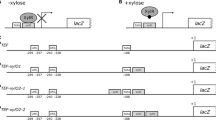Summary
A YCp type promoter-probe vector, pVC701, replicable inSaccharomyces cerevisiae andEscherichia coli hosts was constructed. pVC701 has a DNA fragment bearing thePHO5 gene encoding repressible acid phosphatase (rA-Pase; EC 3.1.3.2.) without its promoter region. The clonedPHO5 gene can be expressed by insertion of a DNA fragment having promoter function at theEcoRI site on the 5′-flanking region ofPHO5. rAPase activity caused by thePHO5 expression is easily detected by staining the transformant colonies with diazo-coupling reagent. These were confirmed by insertion of aHIS5 DNA fragment ofS. cerevisiae having promoter function at theEcoRI cloning site in conditions of histidine starvation. Numerous DNA fragments exhibiting promoter function were isolated by employing pVC701. Most of them expressed thePHO5 gene constitutively, while one of them conferred galactose-inducible and glucose-repressible expression.
Similar content being viewed by others
References
Arima K, Oshima T, Kubota I, Nakamura N, Mizunaga T, Toh-e A (1983) The nucleotide sequence of the yeastPHO5 gene: a putative precursor of repressible acid phosphatase contains a signal peptide. Nucleic Acids Res 11:1657–1672
Arnold WN (1972) Location of acid phosphatase and β-fructofuranosidase within yeast cell envelopes. J Bacteriol 112:1346–1352
Bolivar F, Rodriguez RL, Betlach MC, Boyer HW (1977) Construction and characterization of new cloning vehicles. I. Ampicillin-resistant derivatives of the plasmid pMB9. Gene 2:75–93
Bostian KA, Lemire JM, Cannon LE, Halvorson HO (1980)In vitro synthesis of repressible yeast acid phosphatase: identification of multiple mRNAs and products. Proc Natl Acad Sci USA 77:4504–4508
Bram RJ, Lue NF, Kornberg RD (1986) AGal family of upstream activating sequences in yeast: roles in both induction and repression of transcription. EMBO J 5:603–608
Burkholder PR (1943) Vitamin deficiencies in yeasts. Am J Bot 30:206–211
Casadaban MJ, Martinez-Arias A, Shapira SK, Chou J (1983) β-Galatosidase gene fusions for analyzing gene expression inEscherichia coli and yeast. Methods Enzymol 100:293–308
Clarke L, Carbon J (1978) Functional expression of cloned yeast DNA inEscherichia coli: specific complementation of argininosuccinate lyase (argH) mutations. J Mol Biol 120:517–532
Corden J, Wasylyk B, Buchwalder A, Sassone-Corsi P, Kedinger C, Chambon P (1980) Promoter sequences of eukaryotic protein-coding regions. Science 209:1406–1414
Fitzgerald-Hayes M, Clarke L, Carbon J (1982) Nucleotide sequence comparisons and functional analysis of yeast centromere DNAs. Cell 29:235–244
Harashima S, Takagi A, Oshima Y (1984) Transformation of protoplasted yeast cells is directly associated with cell fusion. Mol Cell Biol 4:771–778
Hinnebusch AG (1986) The general control of amino acid biosynthetic genes in the yeastSaccharomyces cerevisiae. CRC Crit Rev Biochem 21:277–317
Ito H, Fukuda Y, Murata K, Kimura A (1983) Transformation of intact yeast cells treated with alkali cations. J Bacteriol 153:163–168
Maxam AM, Gilbert W (1980) Sequencing end-labeled DNA with base-specific chemical cleavages. Methods Enzymol 65:499–560
McClure WR (1985) Mechanism and control of transcription initiation in prokaryotes. Ann Rev Biochem 54:171–204
Messing J (1983) New M13 vector for cloning. Methods Enzymol 101:20–78
Miller JH (1972) Experiments in molecular genetics. Cold Spring Harbor Laboratory, Cold Spring Harbor, NY
Morrison DA (1977) Transformation inEscherichia coli: cryogenic preservation of competent cells. J Bacteriol 132:349–351
Nishiwaki K, Hayashi N, Irie S, Chung D-H, Harashima S, Oshima Y (1987) Structure of the yeastHIS5 gene responsive to general control of amino acid biosynthesis. Mol Gen Genet 208:159–167
Sassone-Corsi P, Borrelli E (1986) Transcriptional regulation bytrans-acting factors. Trends Genet 2:215–219
Stinchcomb DT, Mann C, Davis RW (1982) Centromeric DNA fromSaccharomyces cerevisiae. J Mol Biol 158:157–179
Tajima M, Nogi Y, Fukasawa T (1986) Duplicate upstream activating sequences in the promoter region of theSaccharomyces cerevisiae GAL7 gene. Mol Cell Biol 6:246–256
Toh-e A, Oshima Y (1974) Characterization of a dominant-constitutive mutation,PHOO, for the repressible acid phosphatase synthesis inSaccharomyces cerevisiae. J Bacteriol 120:608–617
Toh-e A, Ueda Y, Kakimoto S, Oshima Y (1973) Isolation and characterization of acid phosphatase mutants inSaccharomyces cerevisiae. J Bacteriol 113:727–738
Yoshida K, Kuromitsu Z, Ogawa N, Ogawa K, Oshima Y (1987) Regulatory circuit for phosphatase synthesis inSaccharomyces cerevisiae. In: Torrian-Gorini A, Silver S, Yagil E, Rothman FG, Wright W (eds) Phosphate metabolism and cellular regulation in microorganisms. American Society for Microbiology, Washington, DC, pp 49–55
Author information
Authors and Affiliations
Rights and permissions
About this article
Cite this article
Hwang, YI., Harashima, S. & Oshima, Y. Construction of a promoter-probe vector with thePHO5 gene encoding repressible acid phosphatase inSaccharomyces cerevisiae . Appl Microbiol Biotechnol 28, 155–159 (1988). https://doi.org/10.1007/BF00694304
Received:
Accepted:
Issue Date:
DOI: https://doi.org/10.1007/BF00694304




